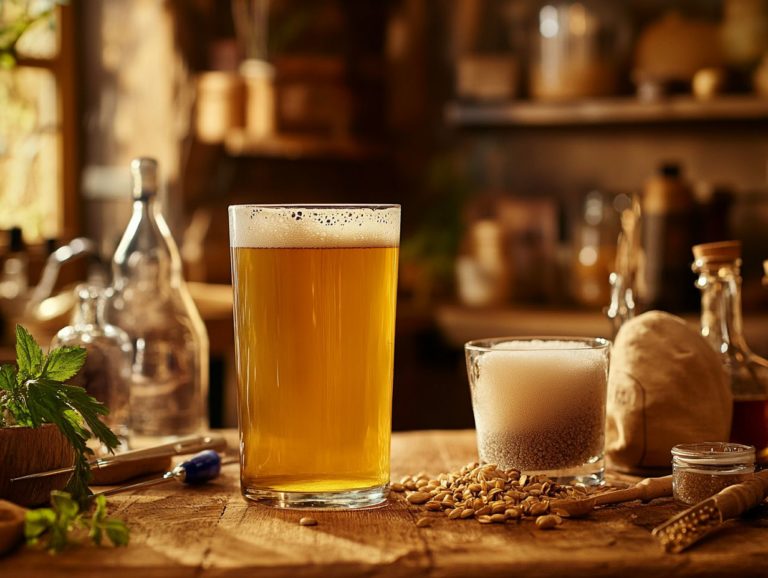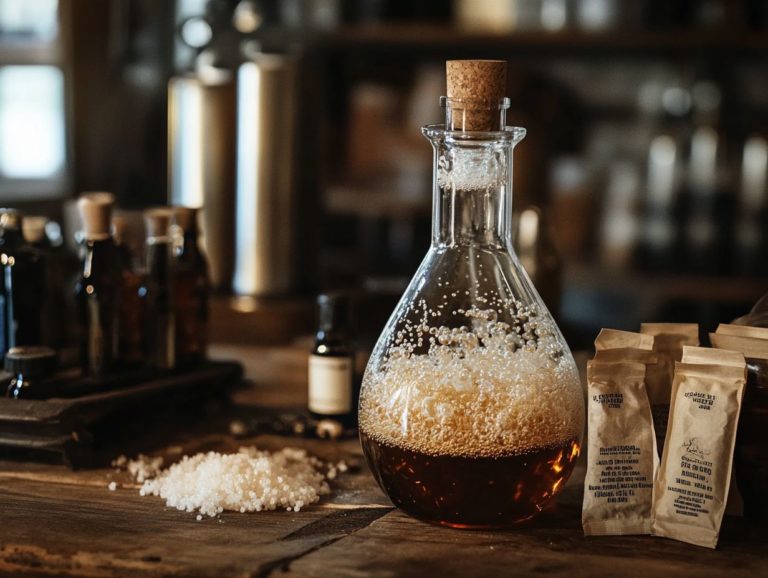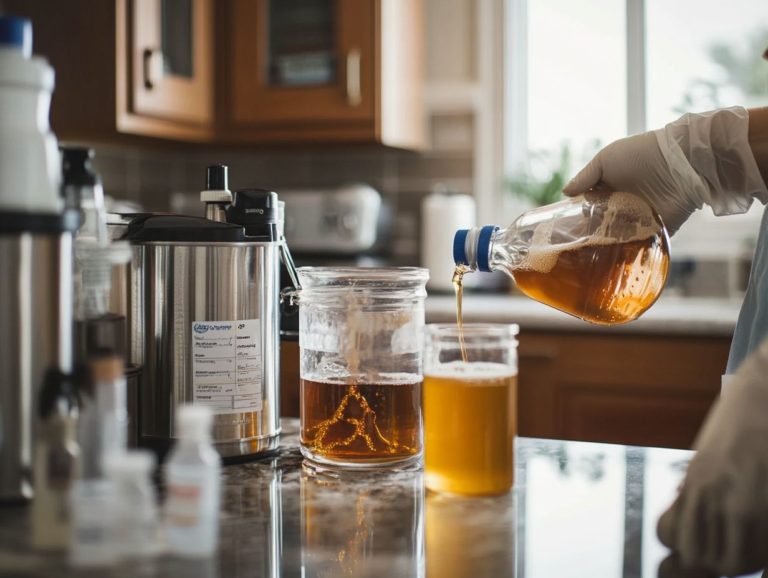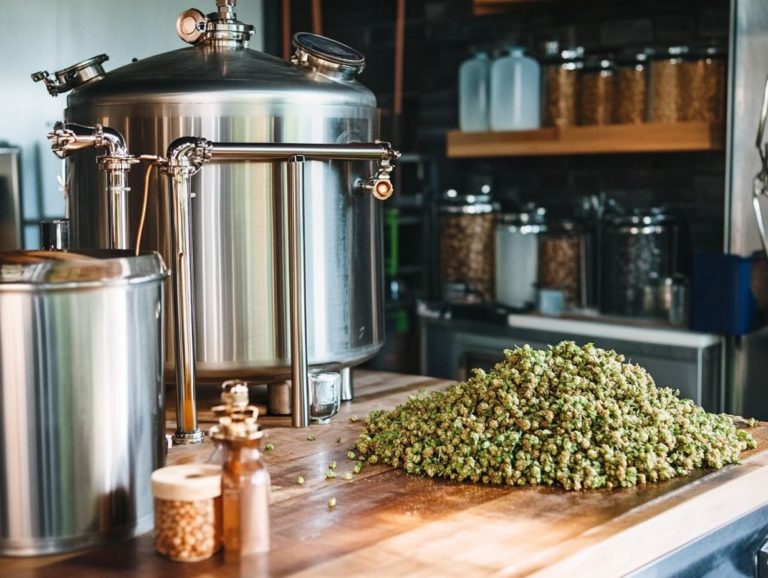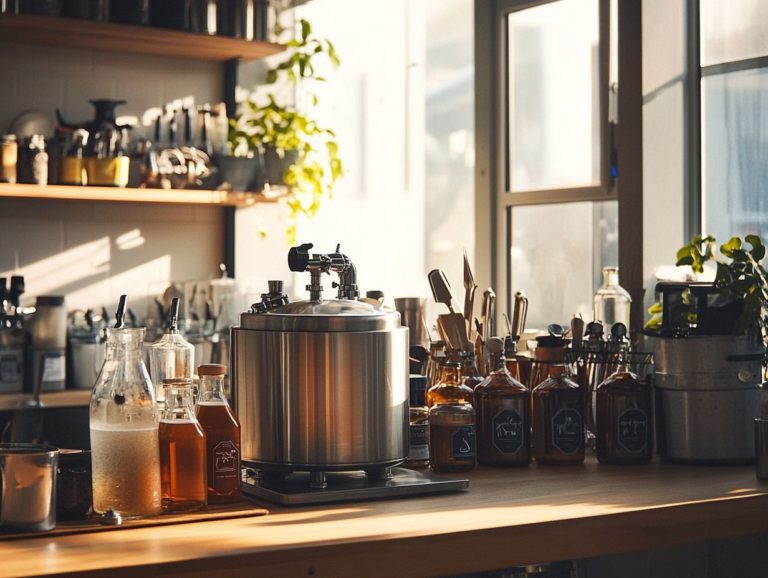Identifying and Fixing Yeast Flocculation Issues
Yeast flocculation is pivotal in the brewing process, affecting everything from the clarity of your beer to its overall flavor profile.
Grasping the factors that contribute to yeast flocculation, recognizing potential issues, and understanding the impact it can have on your brew is essential for any discerning homebrewer or craft beer aficionado.
This guide will illuminate the signs of yeast flocculation problems, present effective testing methods, and offer practical solutions to ensure your beer turns out exactly as you envision it.
Contents
- Key Takeaways:
- What is Yeast Flocculation?
- How to Identify Yeast Flocculation Issues?
- What Are the Signs of Yeast Flocculation?
- How to Test for Yeast Flocculation?
- What Are the Effects of Yeast Flocculation on Beer?
- How Does Yeast Flocculation Affect Beer Flavor?
- How to Fix Yeast Flocculation Issues?
- What Are Some Common Yeast Flocculation Problems and Solutions?
- Frequently Asked Questions
- What is yeast flocculation and why is it important in brewing?
- How can I identify if I have yeast flocculation issues?
- What are some common causes of yeast flocculation issues?
- How can I fix yeast flocculation issues?
- What are some tips for preventing yeast flocculation issues?
- Can yeast flocculation issues be beneficial?
Key Takeaways:
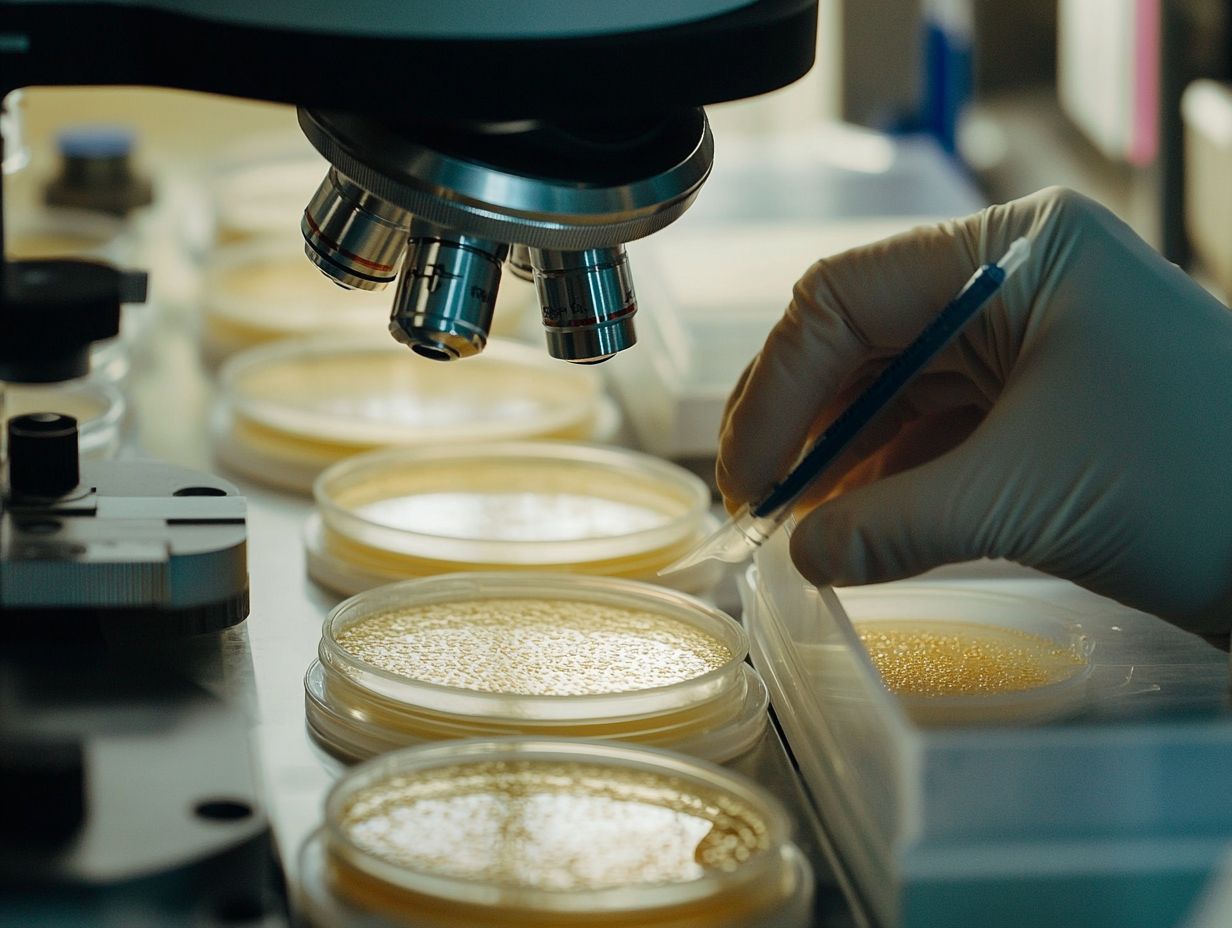
- Yeast flocculation is when yeast clumps together, causing issues in beer production.
- Signs of yeast flocculation include cloudy or hazy beer, low alcohol content, and off-flavors.
- To fix yeast flocculation, testing and prevention methods can be used, such as selecting the right yeast strain and controlling fermentation conditions.
What is Yeast Flocculation?
Yeast flocculation, which is when yeast cells clump together, plays a vital role in brewing. It aids in sedimentation and clarity during fermentation. This process has a significant impact on the quality of the final product, influencing both the structure and appearance of the beer.
To truly understand yeast flocculation, you ll want to explore the biochemistry of yeast strains like Saccharomyces. These strains display different flocculation behaviors based on their genetic makeup and environmental conditions, such as temperature and the protein composition of the wort.
Whether you re a homebrewer or a professional in the industry, grasping these concepts is essential for achieving your desired fermentation results. It also helps in effectively managing any yeast-related challenges that may arise.
What Causes Yeast Flocculation?
Yeast flocculation is influenced by a fascinating interplay of genetic factors and environmental conditions, including temperature and the composition of the wort. You ll notice that different strains of Saccharomyces exhibit unique flocculation traits, shaped by the presence of proteins and polysaccharides, such as mannan and zymolectin, during brewing.
This intricate interaction determines how yeast cells clump together, as they adhere to cell walls and surface characteristics, facilitating sedimentation.
The genetic variations within the yeast strains are crucial for their effective flocculation. These genetic traits dictate the expression of essential flocculation proteins that promote cell aggregation.
The surrounding environmental conditions also impact yeast metabolism, further influencing flocculation behavior. For instance, higher temperatures may boost the expression of flocculation-related proteins, resulting in more substantial clumping.
Furthermore, the presence of certain nutrients or inhibitors in the wort can either support or hinder this clumping process, profoundly affecting fermentation efficiency and the quality of the final product you aspire to create.
How to Identify Yeast Flocculation Issues?
Identifying yeast flocculation issues is essential if you want to master the art of brewing your perfect beer. Poor flocculation can result in undesirable yeast haze, compromising the overall clarity and flavor of your beer.
Whether you’re a homebrewer or a professional, it s essential to be vigilant about the signs of faulty yeast flocculation. You might notice excessive sediment accumulating in the fermenter or a cloudy appearance in your finished product.
Recognizing these indicators early on allows you to adjust fermentation conditions and select the right yeast strains, ensuring that potential problems are effectively mitigated.
What Are the Signs of Yeast Flocculation?
You can observe the signs of yeast flocculation during and after fermentation. Key indicators include clarity of your beer and the amount of sediment at the bottom of the fermenter. Poor flocculation often presents as yeast haze, which results from suspended yeast cells and fermentation byproducts that don t settle correctly. This can impact both the appearance and mouthfeel of your brew.
That haze can really throw a wrench in your brewing plans if you’re aiming for a crisp, clean finish. As fermentation progresses, you may notice varying degrees of clarity. Ideally, well-flocculated yeast will create a compact sediment layer at the bottom, signaling everything is on track. Conversely, if yeast remains suspended, your liquid may take on a murky appearance. This not only looks unappealing but can also influence the flavor profile.
Excess sediment can lead to undesirable off-flavors as yeast continues to interact with brewing components. This underscores the importance of effective flocculation in achieving the results you want for any brewing project.
How to Test for Yeast Flocculation?
Testing for yeast flocculation is crucial for brewers aiming to refine their fermentation process and achieve a clear, high-quality beer. Homebrewers can easily conduct simple tests by observing the sedimentation rate of yeast in a wort sample and measuring its clarity over time. This provides valuable insights into the effectiveness of yeast flocculation in your brewing environment.
Start by collecting a representative wort sample after fermentation. Pour this into a graduated cylinder or clear vessel to observe sedimentation easily. Mark the initial level of yeast suspension, then let the sample sit undisturbed for several hours. After this period, measure how far the yeast has settled. This will give you important information about the sedimentation rate.
For clarity assessment, take note of the wort’s appearance regularly, perhaps using a light source to enhance your judgment of its transparency. The clearer the wort becomes, the more effective the yeast flocculation is, ultimately improving the quality of your finished brew.
What Are the Effects of Yeast Flocculation on Beer?

Yeast flocculation is essential in shaping the characteristics of your beer. It impacts both flavor profiles and visual clarity. High flocculation rates lead to quicker sedimentation, resulting in a cleaner beer with less haze.
Low flocculation can introduce off-flavors due to extended contact with yeast and fermentation byproducts. This can significantly compromise the quality of your final product. By understanding these dynamics, you empower yourself to manipulate flocculation traits effectively, enabling you to craft the beer attributes you desire.
How Does Yeast Flocculation Affect Beer Flavor?
Yeast flocculation directly influences the flavor of your beer. The length of time that yeast interacts with the wort can lead to various fermentation byproducts, including diacetyl, which can introduce unwanted off-flavors. Strains that exhibit high flocculation settle quickly, minimizing the risk of these undesirable flavors. In contrast, low-flocculating yeasts may leave behind residual byproducts in suspension, ultimately altering your intended flavor profile.
The dynamic interplay between yeast and fermentation is crucial in crafting the overall sensory experience of your beer. As yeasts convert sugars into alcohol and carbon dioxide, they also generate various compounds that contribute to aroma and taste. For example, esters produced by certain yeast strains can introduce delightful fruity and floral notes, adding complexity to your brew.
Strains that lack efficient flocculation often produce elevated levels of compounds like buttery diacetyl or even phenolic off-flavors, which can detract from your desired characteristics.
By understanding these relationships, you can make informed choices about yeast and fermentation practices that help you achieve a balanced and rich flavor profile in your brewing endeavors.
Can Yeast Flocculation Affect Beer Clarity?
Yes, yeast flocculation plays a pivotal role in the clarity of your beer. When flocculation occurs effectively, it leads to the formation of sediment that settles at the bottom of the fermenter, effectively removing those pesky suspended particles that can cause haze. As a brewer, you likely aim for optimal flocculation rates to ensure your final product is visually appealing, as clear beer is often equated with quality and craftsmanship.
This sedimentation process isn t just a technical detail; it directly impacts the beer s visual appeal, a critical factor for consumers when selecting their beverage. When yeast clumps together and sinks, it results in fewer particles floating in the liquid, yielding a bright and enticing appearance that enhances the overall sensory experience.
Certain beer styles may prioritize clarity, making yeast flocculation a significant consideration in your brewing process. By managing fermentation conditions and selecting the right yeast strains, you can influence flocculation and, in turn, achieve the clarity that leads to a product that not only tastes exceptional but also looks exquisite.
How to Fix Yeast Flocculation Issues?
Addressing yeast flocculation issues is essential for you as a brewer striving to refine your fermentation process and produce exceptional beer. By tackling the diverse factors that contribute to flocculation challenges, you can adopt effective techniques to either encourage or manage yeast behavior.
This requires a thoughtful selection of yeast strains, vigilant monitoring of fermentation conditions, and the implementation of strategies designed to enhance sedimentation and clarity. Ultimately, these efforts will culminate in an elevated brewing experience, allowing you to enjoy the fruits of your labor in every sip.
How to Prevent Yeast Flocculation in the Future?
Preventing yeast flocculation issues in your future brews is vital for maintaining both consistency and quality in your beer production. You can adopt several strategies, such as selecting yeast strains that are known for their flocculation characteristics, optimizing fermentation temperatures, and ensuring your wort composition is balanced to minimize the risk of undesirable flocculation behavior. By focusing on these preventive measures, you can achieve the clarity and flavor profiles you desire in your beers.
Along with strain selection, monitoring the fermentation environment is paramount. Factors like oxygen levels, pH, and nutrient availability can significantly influence yeast performance and flocculation tendencies.
Using a yeast starter is a great way to ensure a robust yeast population from the beginning, fostering more predictable behavior during fermentation. Regular sampling and assessments throughout the brewing process allow you to make timely adjustments if any issues arise.
Engaging in these practices will not only elevate your brewing experience but also deepen your understanding of how yeast dynamics shape the final product, ultimately leading to better craft beer.
What Are Some Tips for Dealing with Yeast Flocculation?
Effectively managing yeast flocculation involves a set of valuable tips and techniques that can elevate your brewing process and enhance the quality of your beer. As a homebrewer, you should closely monitor fermentation, adjust temperatures when necessary, and experiment with various yeast strains to discover the perfect balance for your unique brewing conditions.
Gaining a solid understanding of the sedimentation process and how to influence yeast behavior can significantly enhance the clarity and flavor of your final product.
To achieve the results you desire, it’s crucial to become familiar with different yeast strains, each possessing unique flocculation characteristics that can impact your brewing outcomes. For example, some strains settle at lower temperatures, while others thrive in warmer conditions, promoting more efficient flocculation. You might consider conducting small trials to pinpoint the optimal temperature range for your chosen yeast.
Incorporating techniques like cold crashing or gently swirling the fermenter can expedite sedimentation, further improving your beer s clarity. Keeping a brewing journal can prove invaluable for tracking these adjustments and their outcomes, ultimately leading to a more refined and enjoyable brewing experience.
What Are Some Common Yeast Flocculation Problems and Solutions?
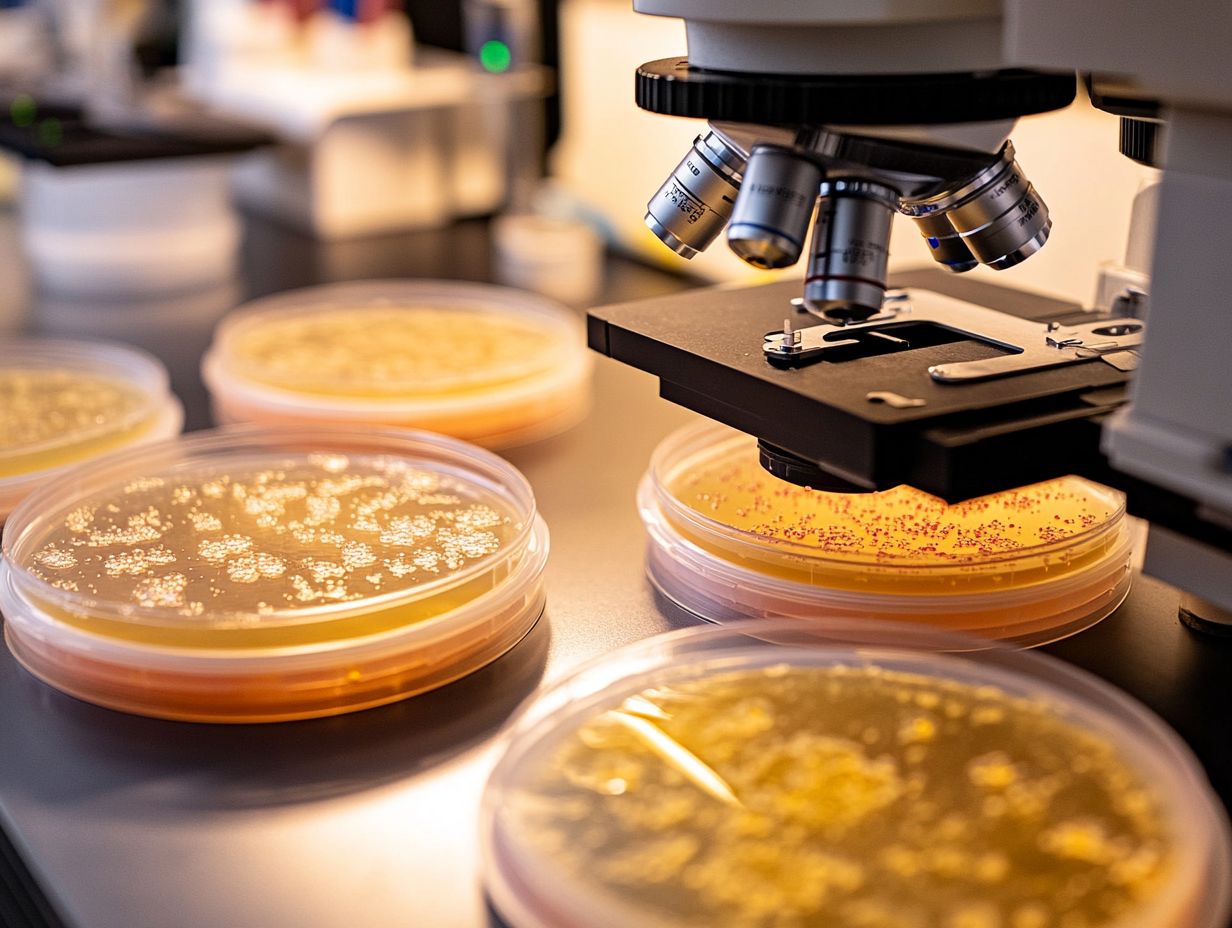
Discover how to master yeast flocculation and elevate your brewing game! Common yeast flocculation problems can present considerable challenges for you as a brewer, influencing both the clarity and flavor profiles of your beer. For instance, high flocculation, where yeast settles too rapidly, can lead to incomplete fermentation. On the other hand, low flocculation may create undesirable yeast haze and off-flavors.
By recognizing these issues and applying targeted solutions, you can refine your fermentation processes and attain the results you desire.
How to Deal with High Flocculation Yeast?
Navigating the challenges posed by high flocculation yeast demands a set of specific strategies. It’s essential to ensure your fermentation process and product quality remain at their finest. When yeast clumps together too swiftly, it can leave behind residual sugars that go unfermented. This can negatively influence the final flavor profile of your beer.
To tackle this issue effectively, maintain a close watch on the fermentation process. Ensure adequate yeast contact time. Consider utilizing fining agents (substances added to clarify the beer) to enhance clarity while managing flocculation rates.
To further elevate your fermentation outcomes, adjust your pitching rates according to the characteristics of the yeast strain you re using. A well-balanced nutrient addition can significantly support healthy yeast growth and longevity.
Controlling the temperature during fermentation helps minimize flocculation and promotes consistent yeast activity. Don t hesitate to experiment with various yeast varieties or blends; some strains are less prone to premature flocculation and may yield superior results.
Regularly evaluating your fermentation process will allow you to make proactive adjustments. This ultimately leads to a more refined and flavorful end product.
What to Do When Yeast Flocculation Occurs Too Early?
When yeast flocculation happens too early during fermentation, it can really put a wrench in the works. This jeopardizes the entire fermentation process and affects the overall quality of your beer. If you find yourself in this situation, it’s crucial to act quickly.
Gently swirling the fermenter can help resuspend the yeast. Adjusting fermentation temperatures might do the trick, or even pitching additional yeast can ensure that fermentation continues as intended. Understanding how to manage early flocculation is key to achieving the desired characteristics in your final product.
It’s also wise to keep a close eye on the specific gravity to assess whether fermentation is progressing smoothly. Utilizing techniques like adding yeast nutrients can facilitate a more vigorous fermentation process, particularly in high-gravity wort.
Maintaining a stable fermentation environment, free from drastic temperature fluctuations, helps keep yeast activity consistent. If early flocculation continues to be a thorn in your side, explore different yeast strains that are less prone to clumping as a long-term solution.
By implementing these strategies, you can enhance fermentation stability and improve beer clarity, ultimately ensuring a superior quality product.
We invite you to share your experiences with yeast flocculation or explore more brewing tips on our site!
How to Handle Low Flocculation Yeast?
Handling low flocculation yeast can be quite the challenge for brewers, often resulting in pesky yeast haze and extended fermentation times. Get ready to tackle these challenges with a variety of techniques at your disposal!
Consider adjusting fermentation temperatures to boost yeast activity, employing fining agents to achieve improved clarity, or opting for high flocculating yeast strains in your future batches. Gaining a solid understanding of the characteristics of low flocculation yeast is essential for producing a clean and visually appealing final product.
You might also think about extending the conditioning duration, giving the yeast ample time to settle naturally, which contributes to a clearer beer. Optimizing your pitching rate is another key factor. Using the right amount of yeast can significantly enhance flocculation through competitive interactions among yeast cells.
Experimenting with different fermentation vessels can yield positive results; wider tanks can facilitate better settling. Don t forget to monitor the health of your yeast, paying attention to nutrient availability and oxygen levels. This ensures robust fermentation and helps to mitigate haze issues.
By adopting these strategies, you can elevate your beer quality and achieve greater brewing success.
What to Do When Yeast Flocculation is Inconsistent?
Inconsistent yeast flocculation can profoundly impact your brewing process, resulting in unpredictable outcomes in both flavor and clarity. Begin by assessing your fermentation practices, paying close attention to temperature control and yeast health.
Try specific solutions, like incorporating yeast nutrient supplements or opting for a more reliable yeast strain, to stabilize flocculation behavior and elevate the overall quality of your beer.
Regularly monitor parameters such as pH levels and oxygen content during fermentation. These checks will provide valuable insights into your yeast’s performance.
Experimenting with different fining agents or adjusting the mash temperature can significantly improve yeast sedimentation.
Understanding the specific characteristics of various yeast varieties will help you select the optimal strain for the particular beer style you’re aiming to create.
Combining these strategies, including optimizing environmental factors and understanding the yeast’s genetic setup, can lead to a more predictable and consistent fermentation process. This ultimately results in a superior product that meets your high standards of quality.
Frequently Asked Questions
What is yeast flocculation and why is it important in brewing?
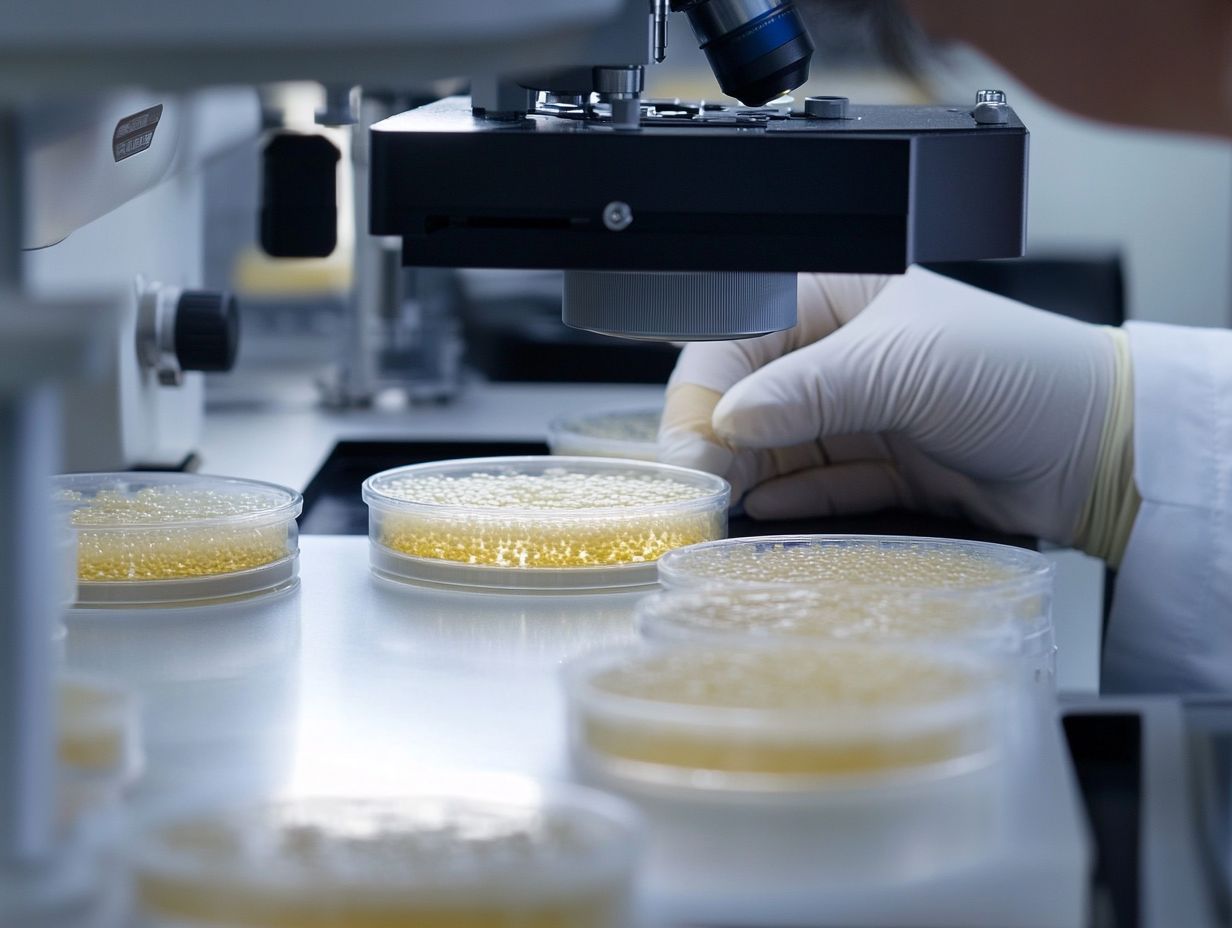
Yeast flocculation is the process by which yeast cells clump together and form sediment at the bottom of the fermentation vessel. This step is crucial in brewing as it helps clarify the beer, improving its flavor and appearance. The flocculent sediment includes various phenotypes of yeast cells and some protein coagulants.
How can I identify if I have yeast flocculation issues?
If your beer appears hazy or cloudy, it may indicate yeast flocculation issues. Excessive sediment or “floaties” can also be signs. Additionally, low alcohol content and off-flavors, or overly yeasty beer, can result from poor yeast flocculation.
What are some common causes of yeast flocculation issues?
Main causes of yeast flocculation issues include high levels of fatty acids in the wort, high fermentation temperatures, and low nutrient levels for the yeast. Other factors, like pH levels, oxygenation, and the type of yeast strain used, such as Saccharomyces, can also play a role. Yeast age and cell charge significantly influence flocculation, as do polyphenols and flocculin proteins on the cell surface.
How can I fix yeast flocculation issues?
The most effective way to fix yeast flocculation issues is to address the underlying cause. This involves adjusting pH levels, using different yeast strains, controlling fermentation temperatures, and ensuring proper oxygenation and nutrient levels.
In some cases, adding a clarifying agent or filtering the beer can improve flocculation. Techniques like co-flocculation and enhanced yeast storage conditions also contribute to better outcomes.
What are some tips for preventing yeast flocculation issues?
To prevent yeast flocculation issues, ensure your wort has enough nutrients for the yeast. It’s crucial to maintain proper fermentation temperatures and pH levels.
Using the right yeast strain for your beer style can also help prevent flocculation issues. Some strains exhibit medium flocculation and high attenuation, beneficial for specific beer styles.
Can yeast flocculation issues be beneficial?
Believe it or not, yeast flocculation issues can actually be beneficial! Some beer styles, like Belgian ales, thrive on a cloudy appearance and benefit from high levels of yeast flocculation.
Some brewers intentionally choose yeast strains with low flocculation to create unique flavors. Strains with specific genetic markers can enhance the desired flavors and characteristics.


